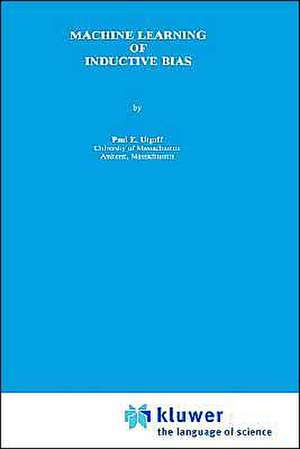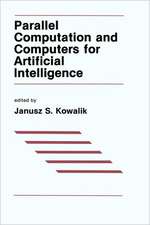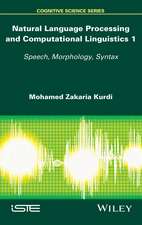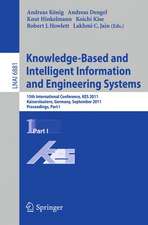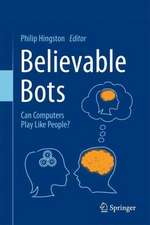Machine Learning of Inductive Bias: The Springer International Series in Engineering and Computer Science, cartea 15
Autor Paul E. Utgoffen Limba Engleză Hardback – 30 iun 1986
| Toate formatele și edițiile | Preț | Express |
|---|---|---|
| Paperback (1) | 640.19 lei 6-8 săpt. | |
| Springer Us – 5 apr 2012 | 640.19 lei 6-8 săpt. | |
| Hardback (1) | 646.95 lei 6-8 săpt. | |
| Springer Us – 30 iun 1986 | 646.95 lei 6-8 săpt. |
Din seria The Springer International Series in Engineering and Computer Science
- 24%
 Preț: 1041.97 lei
Preț: 1041.97 lei - 20%
 Preț: 643.50 lei
Preț: 643.50 lei - 18%
 Preț: 1225.62 lei
Preț: 1225.62 lei - 18%
 Preț: 965.02 lei
Preț: 965.02 lei - 20%
 Preț: 646.12 lei
Preț: 646.12 lei - 18%
 Preț: 948.79 lei
Preț: 948.79 lei - 20%
 Preț: 646.62 lei
Preț: 646.62 lei - 15%
 Preț: 637.46 lei
Preț: 637.46 lei - 20%
 Preț: 643.83 lei
Preț: 643.83 lei - 18%
 Preț: 949.23 lei
Preț: 949.23 lei - 20%
 Preț: 644.48 lei
Preț: 644.48 lei - 20%
 Preț: 994.92 lei
Preț: 994.92 lei - 20%
 Preț: 645.97 lei
Preț: 645.97 lei - 18%
 Preț: 946.87 lei
Preț: 946.87 lei - 20%
 Preț: 995.57 lei
Preț: 995.57 lei - 18%
 Preț: 956.99 lei
Preț: 956.99 lei - 20%
 Preț: 644.98 lei
Preț: 644.98 lei - 15%
 Preț: 649.54 lei
Preț: 649.54 lei - 18%
 Preț: 950.21 lei
Preț: 950.21 lei - 18%
 Preț: 1221.38 lei
Preț: 1221.38 lei - 18%
 Preț: 957.62 lei
Preț: 957.62 lei - 15%
 Preț: 643.99 lei
Preț: 643.99 lei - 18%
 Preț: 948.47 lei
Preț: 948.47 lei - 18%
 Preț: 947.35 lei
Preț: 947.35 lei - 20%
 Preț: 1284.65 lei
Preț: 1284.65 lei - 20%
 Preț: 1628.31 lei
Preț: 1628.31 lei - 20%
 Preț: 1285.78 lei
Preț: 1285.78 lei
Preț: 646.95 lei
Preț vechi: 808.69 lei
-20% Nou
Puncte Express: 970
Preț estimativ în valută:
123.79€ • 129.60$ • 102.43£
123.79€ • 129.60$ • 102.43£
Carte tipărită la comandă
Livrare economică 05-19 aprilie
Preluare comenzi: 021 569.72.76
Specificații
ISBN-13: 9780898382235
ISBN-10: 0898382238
Pagini: 166
Ilustrații: XVIII, 166 p.
Dimensiuni: 155 x 235 x 22 mm
Greutate: 0.46 kg
Ediția:1986
Editura: Springer Us
Colecția Springer
Seria The Springer International Series in Engineering and Computer Science
Locul publicării:New York, NY, United States
ISBN-10: 0898382238
Pagini: 166
Ilustrații: XVIII, 166 p.
Dimensiuni: 155 x 235 x 22 mm
Greutate: 0.46 kg
Ediția:1986
Editura: Springer Us
Colecția Springer
Seria The Springer International Series in Engineering and Computer Science
Locul publicării:New York, NY, United States
Public țintă
ResearchCuprins
1 Introduction.- 1.1 Machine Learning.- 1.2 Learning Concepts from Examples.- 1.3 Role of Bias in Concept Learning.- 1.4 Kinds of Bias.- 1.5 Origin of Bias.- 1.6 Learning to Learn.- 1.7 The New-Term Problem.- 1.8 Guide to Remaining Chapters.- 2 Related Work.- 2.1 Learning Programs that use a Static Bias.- 2.2 Learning Programs that use a Dynamic Bias.- 3 Searching for a Better Bias.- 3.1 Simplifications.- 3.2 The RTA Method for Shifting Bias.- 4 LEX and STABB.- 4.1 LEX: A Program that Learns from Experimentation.- 4.2 STABB: a Program that Shifts Bias.- 5 Least Disjunction.- 5.1 Procedure.- 5.2 Requirements.- 5.3 Experiments.- 5.4 Example Trace.- 5.5 Discussion.- 6 Constraint Back-Propagation.- 6.1 Procedure.- 6.2 Requirements.- 6.3 Experiments.- 6.4 Example Trace.- 6.5 Discussion.- 7 Conclusion.- 7.1 Summary.- 7.2 Results.- 7.3 Issues.- 7.4 Further Work.- Appendix A: Lisp Code.- A.1 STABB.- A.2 Grammar.- A.3 Intersection.- A.4 Match.- A.5 Operators.- A.6 Utilities.
